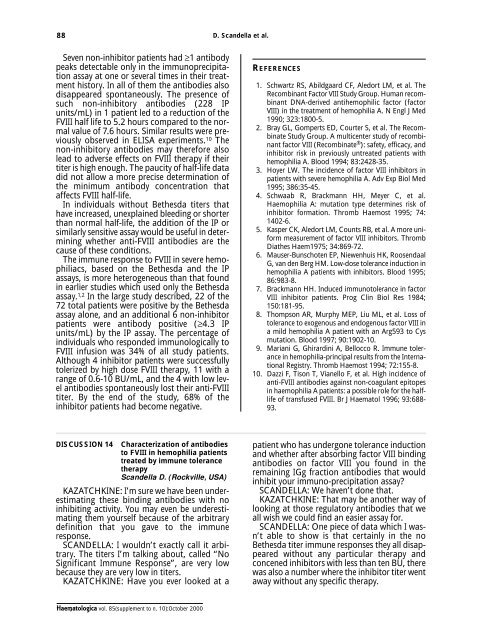Haematologica 2000;85:supplement to no. 10 - Supplements ...
Haematologica 2000;85:supplement to no. 10 - Supplements ...
Haematologica 2000;85:supplement to no. 10 - Supplements ...
Create successful ePaper yourself
Turn your PDF publications into a flip-book with our unique Google optimized e-Paper software.
88<br />
D. Scandella et al.<br />
Seven <strong>no</strong>n-inhibi<strong>to</strong>r patients had ≥1 antibody<br />
peaks detectable only in the immu<strong>no</strong>precipitation<br />
assay at one or several times in their treatment<br />
his<strong>to</strong>ry. In all of them the antibodies also<br />
disappeared spontaneously. The presence of<br />
such <strong>no</strong>n-inhibi<strong>to</strong>ry antibodies (228 IP<br />
units/mL) in 1 patient led <strong>to</strong> a reduction of the<br />
FVIII half life <strong>to</strong> 5.2 hours compared <strong>to</strong> the <strong>no</strong>rmal<br />
value of 7.6 hours. Similar results were previously<br />
observed in ELISA experiments. <strong>10</strong> The<br />
<strong>no</strong>n-inhibi<strong>to</strong>ry antibodies may therefore also<br />
lead <strong>to</strong> adverse effects on FVIII therapy if their<br />
titer is high e<strong>no</strong>ugh. The paucity of half-life data<br />
did <strong>no</strong>t allow a more precise determination of<br />
the minimum antibody concentration that<br />
affects FVIII half-life.<br />
In individuals without Bethesda titers that<br />
have increased, unexplained bleeding or shorter<br />
than <strong>no</strong>rmal half-life, the addition of the IP or<br />
similarly sensitive assay would be useful in determining<br />
whether anti-FVIII antibodies are the<br />
cause of these conditions.<br />
The immune response <strong>to</strong> FVIII in severe hemophiliacs,<br />
based on the Bethesda and the IP<br />
assays, is more heterogeneous than that found<br />
in earlier studies which used only the Bethesda<br />
assay. 1,2 In the large study described, 22 of the<br />
72 <strong>to</strong>tal patients were positive by the Bethesda<br />
assay alone, and an additional 6 <strong>no</strong>n-inhibi<strong>to</strong>r<br />
patients were antibody positive (≥4.3 IP<br />
units/mL) by the IP assay. The percentage of<br />
individuals who responded immu<strong>no</strong>logically <strong>to</strong><br />
FVIII infusion was 34% of all study patients.<br />
Although 4 inhibi<strong>to</strong>r patients were successfully<br />
<strong>to</strong>lerized by high dose FVIII therapy, 11 with a<br />
range of 0.6-<strong>10</strong> BU/mL, and the 4 with low level<br />
antibodies spontaneously lost their anti-FVIII<br />
titer. By the end of the study, 68% of the<br />
inhibi<strong>to</strong>r patients had become negative.<br />
REFERENCES<br />
1. Schwartz RS, Abildgaard CF, Aledort LM, et al. The<br />
Recombinant Fac<strong>to</strong>r VIII Study Group. Human recombinant<br />
DNA-derived antihemophilic fac<strong>to</strong>r (fac<strong>to</strong>r<br />
VIII) in the treatment of hemophilia A. N Engl J Med<br />
1990; 323:1800-5.<br />
2. Bray GL, Gomperts ED, Courter S, et al. The Recombinate<br />
Study Group. A multicenter study of recombinant<br />
fac<strong>to</strong>r VIII (Recombinate ® ): safety, efficacy, and<br />
inhibi<strong>to</strong>r risk in previously untreated patients with<br />
hemophilia A. Blood 1994; 83:2428-35.<br />
3. Hoyer LW. The incidence of fac<strong>to</strong>r VIII inhibi<strong>to</strong>rs in<br />
patients with severe hemophilia A. Adv Exp Biol Med<br />
1995; 386:35-45.<br />
4. Schwaab R, Brackmann HH, Meyer C, et al.<br />
Haemophilia A: mutation type determines risk of<br />
inhibi<strong>to</strong>r formation. Thromb Haemost 1995; 74:<br />
1402-6.<br />
5. Kasper CK, Aledort LM, Counts RB, et al. A more uniform<br />
measurement of fac<strong>to</strong>r VIII inhibi<strong>to</strong>rs. Thromb<br />
Diathes Haem1975; 34:869-72.<br />
6. Mauser-Bunschoten EP, Niewenhuis HK, Roosendaal<br />
G, van den Berg HM. Low-dose <strong>to</strong>lerance induction in<br />
hemophilia A patients with inhibi<strong>to</strong>rs. Blood 1995;<br />
86:983-8.<br />
7. Brackmann HH. Induced immu<strong>no</strong><strong>to</strong>lerance in fac<strong>to</strong>r<br />
VIII inhibi<strong>to</strong>r patients. Prog Clin Biol Res 1984;<br />
150:181-95.<br />
8. Thompson AR, Murphy MEP, Liu ML, et al. Loss of<br />
<strong>to</strong>lerance <strong>to</strong> exoge<strong>no</strong>us and endoge<strong>no</strong>us fac<strong>to</strong>r VIII in<br />
a mild hemophilia A patient with an Arg593 <strong>to</strong> Cys<br />
mutation. Blood 1997; 90:1902-<strong>10</strong>.<br />
9. Mariani G, Ghirardini A, Bellocco R. Immune <strong>to</strong>lerance<br />
in hemophilia-principal results from the International<br />
Registry. Thromb Haemost 1994; 72:155-8.<br />
<strong>10</strong>. Dazzi F, Tison T, Vianello F, et al. High incidence of<br />
anti-FVIII antibodies against <strong>no</strong>n-coagulant epi<strong>to</strong>pes<br />
in haemophilia A patients: a possible role for the halflife<br />
of transfused FVIII. Br J Haema<strong>to</strong>l 1996; 93:688-<br />
93.<br />
DISCUSSION 14 Characterization of antibodies<br />
<strong>to</strong> FVIII in hemophilia patients<br />
treated by immune <strong>to</strong>lerance<br />
therapy<br />
Scandella D. (Rockville, USA)<br />
KAZATCHKINE: I’m sure we have been underestimating<br />
these binding antibodies with <strong>no</strong><br />
inhibiting activity. You may even be underestimating<br />
them yourself because of the arbitrary<br />
definition that you gave <strong>to</strong> the immune<br />
response.<br />
SCANDELLA: I wouldn’t exactly call it arbitrary.<br />
The titers I’m talking about, called “No<br />
Significant Immune Response”, are very low<br />
because they are very low in titers.<br />
KAZATCHKINE: Have you ever looked at a<br />
patient who has undergone <strong>to</strong>lerance induction<br />
and whether after absorbing fac<strong>to</strong>r VIII binding<br />
antibodies on fac<strong>to</strong>r VIII you found in the<br />
remaining IGg fraction antibodies that would<br />
inhibit your immu<strong>no</strong>-precipitation assay<br />
SCANDELLA: We haven’t done that.<br />
KAZATCHKINE: That may be a<strong>no</strong>ther way of<br />
looking at those regula<strong>to</strong>ry antibodies that we<br />
all wish we could find an easier assay for.<br />
SCANDELLA: One piece of data which I wasn’t<br />
able <strong>to</strong> show is that certainly in the <strong>no</strong><br />
Bethesda titer immune responses they all disappeared<br />
without any particular therapy and<br />
concened inhibi<strong>to</strong>rs with less than ten BU, there<br />
was also a number where the inhibi<strong>to</strong>r titer went<br />
away without any specific therapy.<br />
<strong>Haema<strong>to</strong>logica</strong> vol. <strong>85</strong>(<strong>supplement</strong> <strong>to</strong> n. <strong>10</strong>):Oc<strong>to</strong>ber <strong>2000</strong>
















